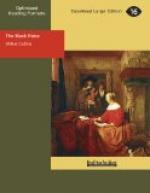THE SEED IS SOWN.
SITUATED in a distant quarter of the vast western suburb of London, the house called The Retreat stood in the midst of a well-kept garden, protected on all sides by a high brick wall. Excepting the grand gilt cross on the roof of the chapel, nothing revealed externally the devotional purpose to which the Roman Catholic priesthood (assisted by the liberality of “the Faithful”) had dedicated the building.
But the convert privileged to pass the gates left Protestant England outside, and found himself, as it were, in a new country. Inside The Retreat, the paternal care of the Church took possession of him; surrounded him with monastic simplicity in his neat little bedroom; and dazzled him with devotional splendor when his religious duties called him into the chapel. The perfect taste—so seldom found in the modern arrangement and decoration of convents and churches in southern countries—showed itself here, pressed into the service of religion, in every part of the house. The severest discipline had no sordid and hideous side to it in The Retreat. The inmates fasted on spotless tablecloths, and handled knives and forks (the humble servants of half-filled stomachs) without a speck on their decent brightness. Penitents who kissed the steps of the altar (to use the expressive Oriental phrase), “eat no dirt.” Friends, liberal friends, permitted to visit the inmates on stated days, saw copies of famous Holy Families in the reception-room which were really works of Art; and trod on a carpet of studiously modest pretensions, exhibiting pious emblems beyond reproach in color and design. The Retreat had its own artesian well; not a person in the house drank impurity in his water. A faint perfume of incense was perceptible in the corridors. The soothing and mysterious silence of the place was intensified rather than disturbed by soft footsteps, and gentle opening and closing of doors. Animal life was not even represented by a cat in the kitchen. And yet, pervaded by some inscrutable influence, the house was not dull. Heretics, with lively imaginations, might have not inappropriately likened it to an enchanted castle. In one word, the Catholic system here showed to perfection its masterly knowledge of the weakness of human nature, and its inexhaustible dexterity in adapting the means to the end.
On the morning when Mrs. Eyrecourt and her daughter held their memorable interview by the fireside at Ten Acres, Father Benwell entered one of the private rooms at The Retreat, devoted to the use of the priesthood. The demure attendant, waiting humbly for instructions, was sent to request the presence of one of the inmates of the house, named Mortleman.
Father Benwell’s customary serenity was a little ruffled, on this occasion, by an appearance of anxiety. More than once he looked impatiently toward the door, and he never even noticed the last new devotional publications laid invitingly on the table.




